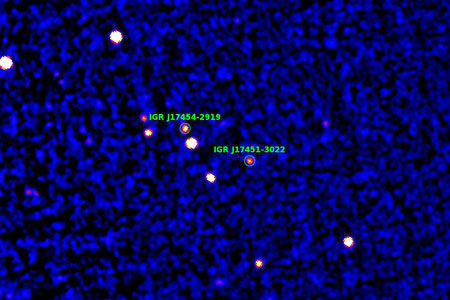Louise Vandbæk Kroer was only meant to be working with a researcher for a single semester—but the collaboration ended in universal delight.
It should have been a relatively standard assignment for Louise Vandbæk Kroer—a 25-year-old BSc student at DTU Space—who was working for Jérôme Chenevez, a senior researcher in the same department, as a part of her study programme. Jérôme was occupied with a project involving receiving data from a satellite that uses special X-ray measuring equipment to keep a watchful eye on our galaxy, the Milky Way. However, the assignment resulted in not one, but two discoveries that went on to attract international interest and highlighted the names of the two researchers in the space exploration community.
The reason is that in August, the measurements from the satellite in revealed something unusual: X-ray radiation from a place where no radiation was believed to exist. Radiation cannot simply appear of its own accord, so Jérôme Chenevez and Louise Kroer immediately took a closer look.
Jérôme was soon able to confirm that they had discovered something new—either a previously unknown black hole, or an as yet undiscovered neutron star—a heavenly body that is a kind of ‘light’ version of a black hole. Precisely what they had discovered was, and remains, unclear, but what is certain is that they have made a new and fascinating discovery.
Just a month later, in September, they did it again. And that was truly sensational. Discovering two X-ray sources, as they are known, within such a short space of time is quite simply unprecedented.
Champagne and snacks
“Only a couple of hundred sources of this kind have been discovered in twelve years of monitoring the stars. But we have now identified two new ones in the same segment as viewed from Earth in the space of a month. That is quite uncommon,” explains Jérôme Chenevez.
“People were incredibly excited. Champagne and snacks were served at the weekly researchers’ meeting, and I was invited along as well,” relates a clearly delighted Louise Vandbæk Kroer.
"It’s amazing to be involved in something like this. It gives you a real sense of what your studies are all about."
Louise Vandbæk Kroer
“It’s amazing to be involved in something like this. It gives you a real sense of what your studies are all about, and, of course, it’s great to be mentioned as the co-author of astronomical telegrams.”
Astronomical telegrams are the messages astronomers send to colleagues all over the world when they make significant new discoveries. The telegram sent from DTU attracted a great deal of attention from all parts of the world, as Jérôme Chenevez relates:
“I could immediately see that physicists in countries including Chile, the Netherlands and the United States were using their access to other satellites to observe the phenomenon we’d discovered. So it created a bit of a landslide for other astrophysicists.”
“And it’s a long way from over. The next step is for us to check through all the data we have collected using different instruments and telescopes, so we have a whole lot of information to analyse. Researchers in Italy and the United States, for example, are already working on it. Once we have analysed our data, we’ll write an article laying out all our findings in detail,” he adds, describing the work for the immediate future.
The information that can be generated by taking measurements of black holes in the universe is unique, because the conditions are so extreme. Both gravity and the magnetic field in a neutron star are around a hundred million times as powerful as on Earth, and the temperatures can reach several million degrees Celsius. These are conditions which it is impossible to recreate on Earth for obvious reasons, so, as Jérôme Chenevez explains, both black holes and neutron stars provide information about what is known as ‘extreme physics’.
He admits, however, that the practical application of the knowledge you acquire is rather limited.
“Then again, no-one could envisage a use for electric filament lights when they were first invented,” he points out.

Pose points
Ever since she was a little girl and her father took her outside one night to look at the stars, Louise Vandbæk Kroer has dreamed of making space her workplace—initially as an astronaut, more recently as a student of Earth and Space Physics and Engineering at DTU. Her recent experience has rekindled her passion for her studies.
“There is so much that is not known about the universe, so much which has still to be discovered. It’s just so vast. Following this experience, I’ve naturally become even more fired up about what I do, because it’s been truly amazing. And yes, I have brought it up with family and friends—there are a couple of ‘pose points’ in it,” she chuckles.
A lot of heavenly bodies are named after the people who discovered them, but there will not be any black holes named Jérôme or Louise this time around. The reason for this is that discoveries of this kind are named after the satellite involved and the spatial coordinates, so the two have been given the easily pronounceable monikers of IGR J17451-3022 and IGR J17454-2919.
Article in DTUavisen no. 2, February 2015.